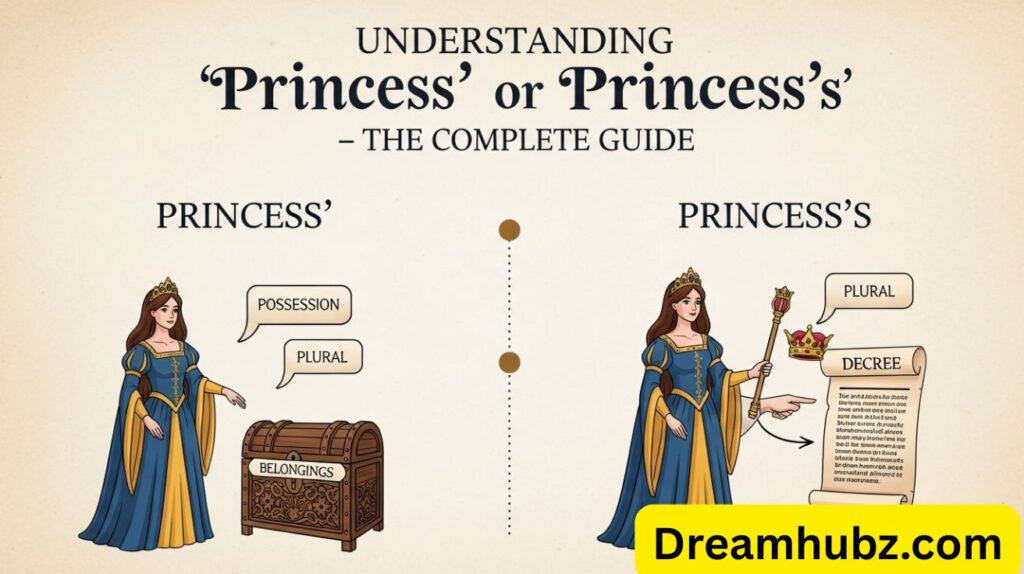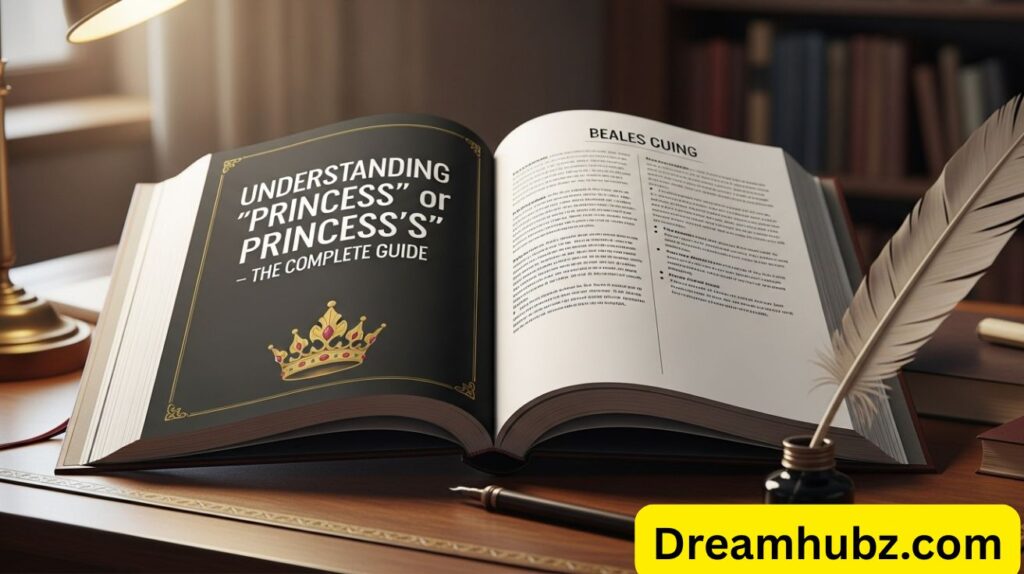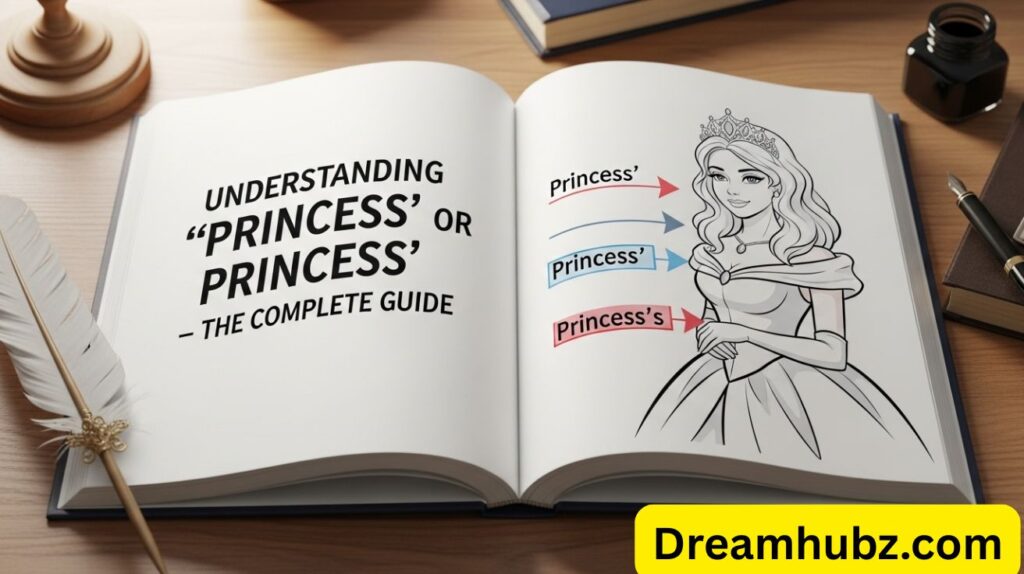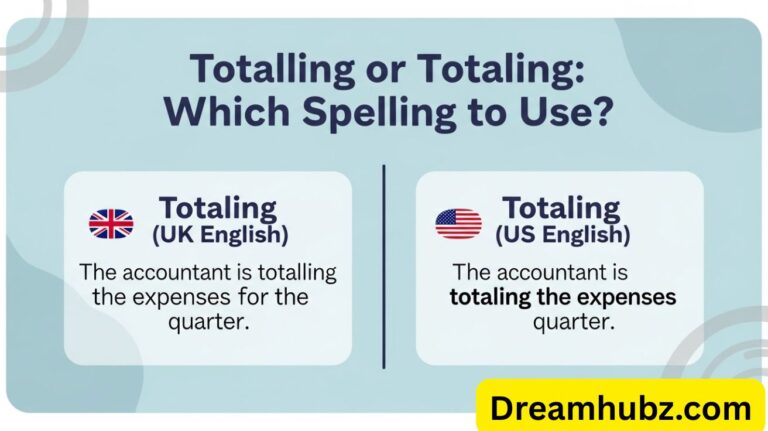Understanding “Princess’ or Princess’s” – The Complete Guide
“Princess’ or Princess’s” shows the possessive form of the word princess. It explains how to show ownership, like the princess’s crown. The confusion comes from where to place the apostrophe.
Many writers wonder which one is right. Is it princess’ dress or princess’s dress? This small mark can change the whole sentence.
The answer depends on grammar rules and style guides. Some use princess’s for one princess. Others accept princess’. Both are correct in different guides.
Singular and Plural Forms: A Refresher

Before we talk about possessives, it is important to understand the difference between singular possessive nouns and plural possessive nouns. Knowing the base singular and plural forms will make the rest of the rules much easier to follow.
Singular Form
A singular noun refers to just one person, place, or thing. The word princess is singular because it refers to only one royal woman. For example, when you say The princess is preparing for the royal ball, the word princess is not showing ownership; it is only naming one individual. Understanding this foundation helps you when you begin forming singular vs plural possessive examples.
Plural Form
The plural of princess is formed by adding -es, which makes it princesses. For instance, in the sentence The princesses are gathering for the ceremony, the word shows that there are many princesses, but again, no ownership is expressed yet. Once you add ownership, you move from a simple plural to a plural possessive noun.
Understanding Possessive Forms
The princess possessive form shows ownership. For example, when you say The princess’s crown, you mean the crown belongs to one princess. In contrast, when you write The princesses’ crowns, you mean that several crowns belong to several princesses.
Possessives are created by using apostrophes. This is where the confusion often starts. English grammar apostrophe usage changes depending on whether the word is singular or plural, and whether it already ends in s. Knowing the punctuation rules in English helps you make these choices correctly and avoid proofreading possessive errors later.
Singular Possessive Form
To show possession for a single princess, you generally add an apostrophe followed by s. That means the correct form is princess’s. For example, The princess’s gown was beautiful. Here, the gown belongs to one princess.
According to the Chicago Manual of Style possessives, this is always the correct form. Chicago insists on adding ’s for all singular possessive nouns, even if the word already ends in s. The sentence The princess’s throne was majestic follows this rule perfectly.
On the other hand, the AP Style possessives guide, which is often used in journalism and media writing, suggests that proper names ending in s may drop the extra s. For instance, it would be James’ car instead of James’s car. However, the word princess is not a proper name but a common noun. Therefore, in AP style, you would still write princess’s crown and not princess’ crown.
This shows that knowing style guide grammar differences matters when you are writing for a specific audience.
Plural Possessive Form
When more than one princess owns something, the rule is different. Because the plural of princess already ends in -es (making princesses), you only add an apostrophe after the final s. That means the correct form is princesses’.
For example, in the sentence The princesses’ advisors met to discuss state matters, the advisors belong to more than one princess. This is how you create plural possessive nouns for words ending in -s.
If you compare this to an irregular plural, like children, the form is children’s. That is why writers often confuse children’s vs princess’s vs princesses’. The rules change depending on whether the plural already ends in s.
Why the Apostrophe Placement Matters
The difference between princess’s and princesses’ is small in writing but very big in meaning. If you write The princess’s jewels sparkled in the light, it is clear that only one princess owns the jewels. But if you write The princesses’ jewels sparkled in the light, it tells the reader that many princesses own jewels.
This is why apostrophe placement in writing matters so much. A single apostrophe changes the ownership from one person to many. Mistakes here can lead to confusing or even misleading sentences.
Common Confusion: Understanding “Princess’ or Princess’s?”
The Rule
When discussing princess’ vs princess’s, most grammar experts agree that the safest option is to use princess’s for singular possession. This follows grammar rules for possessives and is consistent with Chicago Manual of Style possessives.
However, when writing for news outlets in the U.S., many editors follow AP Style possessives. That guide allows you to drop the extra s only for proper nouns possessive rules, such as Charles’ speech. For common nouns like princess, the correct form is still princess’s.
Breaking Down the Misconceptions
Many writers think they should always drop the final s when a word ends in s, but that is incorrect. Another misconception is that princess’ can be used for singular possession in all situations. In reality, the correct choice depends on whether the word is singular or plural, and on which style guide you are following. A quick test helps: ask yourself if you are writing about one princess or multiple princesses. If it is one, use princess’s. If it is more than one, use princesses’.
Examples of Possessive Forms in Context
Singular Possessive in Everyday Use
In storytelling, you might write The princess’s crown was placed carefully on her head. In this case, one princess is preparing for a royal event, and ownership is shown clearly.
Plural Possessive in Everyday Use
If your story has many royal women, you could write The princesses’ responsibilities included meeting with ambassadors and attending state dinners. This shows that the responsibilities belong to all of them together.
Quick Reference Table: Singular vs. Plural Possessive Forms
| Noun | Possessive Form | Example |
| Singular | Princess’s | The princess’s horse was decorated with ribbons. |
| Plural | Princesses’ | The princesses’ charity work inspired the kingdom. |
This simple possessive form chart makes it easier to remember.
Real-Life Applications
Email Communication
In professional writing, correct grammar matters. For example, you might write: Please confirm the princess’s arrival time for the gala. If you are talking about more than one, you could write: The princesses’ public appearances have been scheduled for next week.
Social Media Posts
Online writing also benefits from correct grammar. A post could say: The princess’s inspiring speech went viral around the world. Or, if multiple royals are involved: The princesses’ charity work continues to touch lives globally.
These real examples show how correct usage makes your writing both professional and clear.
Read Also : Totalling or Totaling: Which Spelling to Use?
Common Mistakes to Avoid Understanding “Princess’ or Princess’s?”

The most frequent mistakes include leaving out the apostrophe completely, as in The princesss gown, which is wrong. Another mistake is confusing singular and plural possessives, writing The princesses crown when you meant just one princess. Writers also make errors by mixing styles, such as using princess’s in one sentence and princess’ in the next. Good grammar tips for writers include choosing one style guide and sticking to it throughout your work.
Why Grammar Matters
Clarity and Precision
Correct possessive apostrophe examples remove ambiguity. If you write The princesss gown, readers may be confused, but if you write The princess’s gown, the meaning is clear and precise. Good punctuation rules in English always aim to make writing easier to understand.
Professionalism in Writing
Correct grammar is not just about clarity; it also shows professionalism. In business, academic, and media contexts, mistakes with grammar for professional writing can reduce credibility. Using the right possessive forms demonstrates attention to detail and respect for your audience.
Style Guide Comparisons
The difference between princess’ vs princess’s often depends on the style guide you follow. The Chicago Manual of Style possessives recommends always adding ’s to singular nouns, even when they end in s. That means you would write the princess’s gown to show ownership. This rule applies to common nouns and proper nouns alike, ensuring absolute consistency in writing.
On the other hand, the AP Style possessives guidelines are a little different. AP allows dropping the extra s after an apostrophe for proper nouns possessive rules like James’ speech. However, for common nouns such as princess, AP still accepts princess’s. Knowing these style guide grammar differences is essential, especially when writing for professional or media outlets that follow specific standards.
Tips for Mastering Possessive Grammar
The easiest way to master the princess possessive form is to remember this rule: one princess gets princess’s, but many princesses get princesses’. This simple trick avoids most common grammar mistakes with apostrophes. Writers should also keep a personal possessive form chart handy when drafting, especially if they often work with words ending in s.
Practice helps too. Writing sentences daily with both singular possessive nouns and plural possessive nouns will build confidence. Use tools to spot proofreading possessive errors and study possessive apostrophe examples from reliable sources. Above all, stay consistent. Whether following Chicago or AP, applying the same rule throughout ensures professionalism and avoids confusion in all forms of grammar for professional writing.
How Apostrophes Shape Meaning in Sentences

A small apostrophe can completely change the meaning of a sentence. For instance, the princess’s crown shows ownership by one princess, while the princesses’ crowns indicates that several crowns belong to multiple princesses. These subtle changes highlight why learning English grammar apostrophe usage is vital for clarity, especially in formal writing or storytelling.
When apostrophes are misplaced, readers may misinterpret the message. A missing or wrongly placed mark can shift ownership, change subjects, or create confusion. This is why mastering grammar rules for possessives and understanding how apostrophe placement impacts meaning is critical. Effective writers rely on these rules to ensure that every sentence delivers the intended idea without unnecessary ambiguity or errors.
Why Writers Struggle with Possessive Nouns Ending in S
Many writers find it confusing to work with nouns ending in -s possessive forms like princess, boss, or class. The debate about whether to add ’s or just an apostrophe has existed for decades. Style guides often disagree, which adds another layer of complexity for students, professionals, and even journalists trying to remain consistent.
The confusion becomes worse when switching between singular possessive nouns and plural possessive nouns. Words such as princess’s, princesses’, and children’s look similar but follow different rules. Without a strong grasp of possessive apostrophe examples and practice, mistakes easily occur. This is why writers need structured guidance, reference charts, and constant review of punctuation rules in English to avoid repetitive errors in formal communication.
The Role of Possessive Grammar in Professional Communication
In professional settings, grammar reflects attention to detail. A simple error in apostrophe placement in writing can make documents look unpolished. For example, mixing up princess’s duties with princesses’ duties changes meaning and may weaken the writer’s credibility. Correct grammar for professional writing ensures precision, which is vital in emails, reports, and published materials.
Employers, editors, and readers expect consistency. A polished sentence like the princess’s responsibilities are clear demonstrates skill and care, while mistakes suggest haste or lack of understanding. Using a possessive form chart as a guide, reviewing style guide grammar differences, and practicing with real-life cases are excellent ways to master possessives. Over time, grammar mastery strengthens both professional image and confidence.
FAQ,s
Is it princesses or princess’s?
Princesses is the plural form, while princess’s is the singular possessive form.
How do you say multiple princesses?
You say princesses to refer to more than one princess.
What are princes and princesses called?
Together, they are called royalty or royal family members.
Which is the correct plural form?
The correct plural form is princesses.
Conclusion: Mastering “Princess’ or Princess’s”
The choice between princess’ vs princess’s depends on context and style. If you are talking about one princess, the form is always princess’s. If you are writing about many princesses, the correct form is princesses’. Following the Chicago Manual of Style possessives ensures consistency, while being aware of AP Style possessives helps if you write for news outlets.
With practice, you will avoid common grammar mistakes with apostrophes, strengthen your grammar for professional writing, and confidently apply apostrophe placement in writing. As the Chicago guide reminds us, “Clarity is the ultimate goal of punctuation.” By mastering the princess possessive form, you will also master many other challenges of English grammar.







